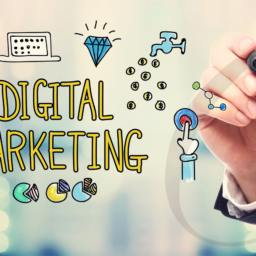
We live in highly advanced technological times, no breaking news there. Robots with emotions and flying cars are no longer just a geek’s imagination. Anything and everything is being automated. Anything and everything is being made digital. So it goes without saying, an essential key to success for businesses these days is to have a prominent digital identity. A digital image that is stamped in the minds of your customers and if executed expertly, in the hearts of the masses.
The internet in its new-born years. Yes, nostalgia.
As the digital world has evolved over the years, the means of establishing your brand and your digital image has evolved alongside it. When the internet was first made available publicly, it was mainly a platform for electronic mail (see: e-mail) and Yahoo! and AOL chat rooms. Using it as a means to boost business revenues hadn’t crossed the minds of entrepreneurs outside of the tech industry, because then, most were still intimidated with a machine that was way smarter than them. Of course, times have changed drastically, because today, even grandma and grandpa have a Facebook account.

In 1999, Yahoo! acquired Geocities, mainly a web-hosting service, but essentially allowed non-technical users to easily build websites. It was around this time when businesses started trickling out from under the proverbial rock and started exploring the innovation of having a website. Although at the time, with very limited customization, and unlimited use of marquees and the notorious Comic Sans font, websites weren’t exactly a site for sore eyes (pun intended).
Thank God for Web 2.0.
When the possibilities of aesthetically pleasing websites finally graced us with their presence, we witnessed major advancements in the commercial use of the Internet. Electronic commerce (or e-commerce as we better know it) started to pick up pace as it offered a lot of advantages for businesses as opposed to their brick-and-mortar counterparts. Amazon.com, today’s front runner in online retail, made its first sale in 1995, and paved the path for businesses to explore the world of e-commerce. It has since grown to a colossal conglomerate.


At the turn of the millennium, we saw the boom of mobile phones and life would never be the same again. When the smartphone was invented, it took no time for the “there’s an app for that” era to flourish. People would use their phones more than any other gadget they owned. However, if you opened a website on your mobile, the layout is squished in a tiny screen, and most of the time causing the layout to be out of order, with most of the images and tables running out of the page.
This opened the doors to going ‘mobile-first’ – a development strategy adopted by many businesses that wanted to get with the times. A beautiful, information-loaded, feature-packed website on a desktop was no longer sufficient. Having a mobile-friendly counterpart was important too. Initially, this was dealt by having two separate versions and website URLs for mobile and desktop, as shown in the example above. Your web browser will smartly open the suitable version by detecting whether you’re browsing from your desktop/laptop or from your phone. User experience was back on track.

But just when you thought things were going smooth again, tablets started coming into the picture. Then you suddenly have so many screen sizes and resolutions to cater to. Responsive design was the lifesaver to this messy situation and once again, user experience no longer needed to be compromised. So we can say at this point, a good website meant a perfect combination of user-friendliness, neat organisation of content, and precise portrayal of information. If you’re a business that cares about your brand, all of these are taken into consideration.
But now that everyone has a website, how can your brand stand out?

The new means of having a competitive advantage in the market is no longer going ‘mobile-first’ but instead to go, if I may, ‘social-first’. With much credit to social platforms like Facebook, Instagram, and Twitter, businesses have never worked so close and interacted as much with their customers as they do today. By reading customer ratings and reviews and following their follower’s conversations, they can get instant feedback about their company and know where they can improve, directly from their customers themselves. Companies who handle their social media presence well are often shone under the spotlight as this reflects that their priority is customer satisfaction and that they are actively involved in updating their content to be hip and current.
Although social media is the “now” in digital image branding, like many platforms before it, this could change overnight. The trick is to roll with the changes and be an early adapter. Businesses must aim to stay with the times and always be ready for the next phase of the digital image evolution.



